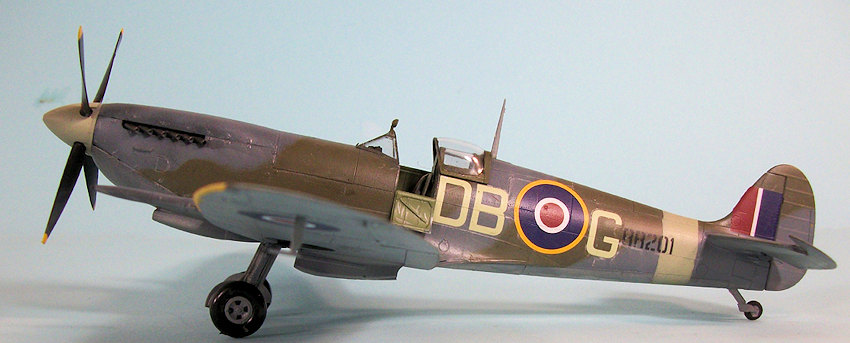
Eduard 1/48 Spitfire IXe
| KIT #: | 1198 |
| PRICE: | $75.00 SRP |
| DECALS: | Six options |
| REVIEWER: | Tom Cleaver |
| NOTES: | Dual Combo |

| HISTORY |
The Spitfire XVI is a Mk. IX airframe with a Packard-built Merlin-266 engine. The type began production in the fall of 1944; however, delivery delays by Packard resulted in the type not becoming operational until late 1944. The type was optimized for low-level operation, and was employed primarily in ground-attack in the final stages of the war in northwestern Europe.
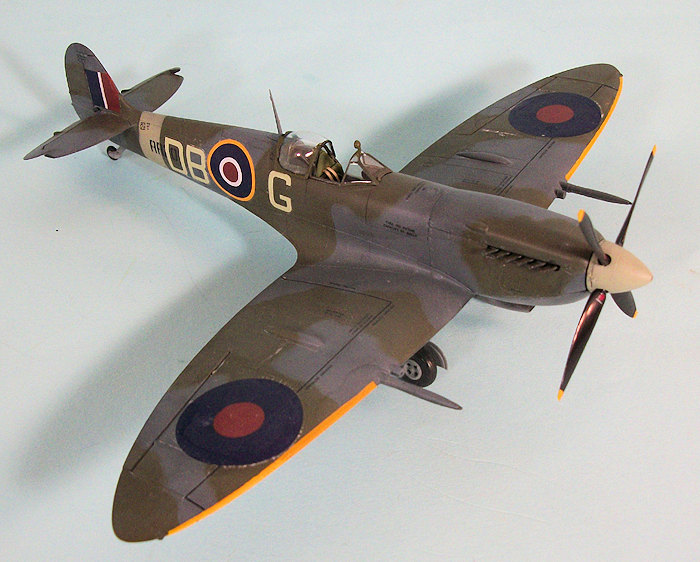 The Spitfire XVI and
the Spitfire IXe were identical airframes, with the only difference being the
powerplant - an American Packard-Merlin in the XVI, a RR-Merlin in the IXe. In
photos, they can only be differentiated by serial number.
The Spitfire XVI and
the Spitfire IXe were identical airframes, with the only difference being the
powerplant - an American Packard-Merlin in the XVI, a RR-Merlin in the IXe. In
photos, they can only be differentiated by serial number.
Dick Audet - “Ace in a Day”:
French Canadian Richard “Dick” Audet enjoyed a spectacular if brief career as a Spitfire ace in the closing stages of the war in Europe. While gaining his wings in October 1942 and being sent immediately to Britain, he would spend the next two years flying with second-line units, including an Army Co-Operation Squadron towing targets for anti-aircraft gunners. These humdrum missions, however, allowed him to build experience.
Flt. Lt. Audet was posted to 411 Squadron in September 1944, based in Holland. He was appointed a flight commander the next month. The squadron flew Spitfire IXs in support of the Allied campaign in Holland following the failure of Operation Market-Garden. He had flown 52 missions by 28 December.
On 29 December, with
the Battle of the Bulge in full swing, 411 Squadron’s spitfire IXEs were
scrambled from Heesch Airdrome in Holland, with orders to patrol Rheine Airdrome
to watch forthe take-off of Me-262s. Shortly after their arrival, Yellow Flight
Leader Audet spotted four Bf-109s and eight Fw-190s at low
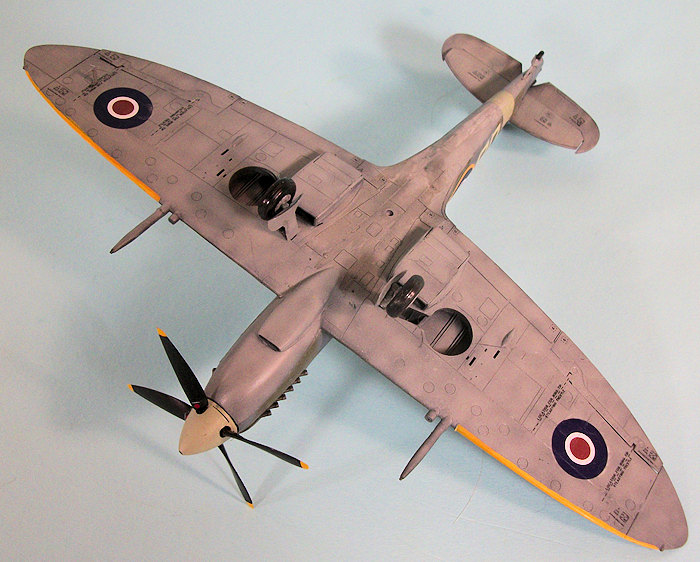 altitude. Audet led
his flight down on them, attacking the rear Bf-109 from 200 yards. The enemy
fighter quickly caught fire and went down. He then spotted an Fw-190 and
attacked from 250 yards down to 100, when he saw the enemy pilot slumped in his
cockpit as the fighter nosed over and went down. Ahead was a second Bf-109.
Audet gave it a burst and the pilot baled out though his parachute failed to
open. Spotting an Fw-190 being pursued by a Spitfire being pursued by a second
Fw-190, Audet called the Spitfire pilot to break and attacked the rear Fw-190
which caught fire and went straight in. During this fight, his canopy flew off!
Several minutes later, as Audet attempted to reform his flight, he spotted
another Fw-190; when he dove on it, the pilot turned into him. Audet opened fire
and the Fw-190 flipped over and went down. The others in his flight also claimed
three other enemy fighters shot down. Evidence suggests that all three Fw-190s
Audet shot down were from 9.III/JG 54.
altitude. Audet led
his flight down on them, attacking the rear Bf-109 from 200 yards. The enemy
fighter quickly caught fire and went down. He then spotted an Fw-190 and
attacked from 250 yards down to 100, when he saw the enemy pilot slumped in his
cockpit as the fighter nosed over and went down. Ahead was a second Bf-109.
Audet gave it a burst and the pilot baled out though his parachute failed to
open. Spotting an Fw-190 being pursued by a Spitfire being pursued by a second
Fw-190, Audet called the Spitfire pilot to break and attacked the rear Fw-190
which caught fire and went straight in. During this fight, his canopy flew off!
Several minutes later, as Audet attempted to reform his flight, he spotted
another Fw-190; when he dove on it, the pilot turned into him. Audet opened fire
and the Fw-190 flipped over and went down. The others in his flight also claimed
three other enemy fighters shot down. Evidence suggests that all three Fw-190s
Audet shot down were from 9.III/JG 54.
All this high-angle gunnery was possible by use of the gyro gunsight Audet’s airplane was equipped with. His five victories were witnessed by the other pilots and confirmed by his gun camera film. Dick Audet was the only Spitfire “Ace in a Day” in the ETO. He was awarded the DFC for this action.
During January 1945, he demonstrated his success was no fluke, shooting down five more enemy aircraft including an Me-262. On 3 March 1945, during a low-level strafing attack on a German train on a siding, Audet was hit by flak; his Spitfire exploded when it hit the ground.
| THE KIT |
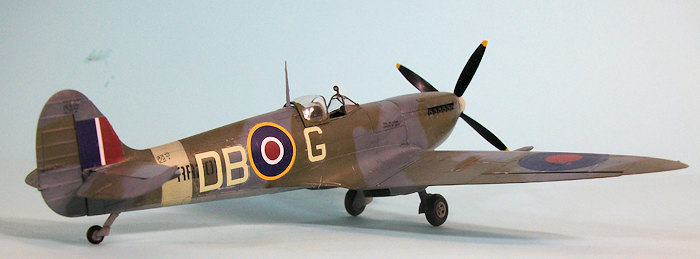 Eduard’s “dual combo”
kit allows a modeler to build both a “high back” and “low back” Spitfire XVI. A
plus in the kit not available in later releases of the “lowback” version by
itself is that there are upper wing parts for both the “early” version without
the bulge over the main gear well, and for the “late” version with this.
Separate wheels and hubs are provided for both types. The single-kit “Profipack”
and “Weekender” releases only include the later upper wing.
Eduard’s “dual combo”
kit allows a modeler to build both a “high back” and “low back” Spitfire XVI. A
plus in the kit not available in later releases of the “lowback” version by
itself is that there are upper wing parts for both the “early” version without
the bulge over the main gear well, and for the “late” version with this.
Separate wheels and hubs are provided for both types. The single-kit “Profipack”
and “Weekender” releases only include the later upper wing.
Decals are provided for six aircraft, three of each sub-type, printed by Cartograf. Since this is a “Profipack” release, photo-etch details are also included for the instrument panel, seat belts, and other fine details.
| CONSTRUCTION |
Construction of the
Eduard Spitfires is “fiddly” due to what I think of as “over-design” of details
like the wheel wells. The secret to building an Eduard Spitfire is to thoroughly
clean up all parts once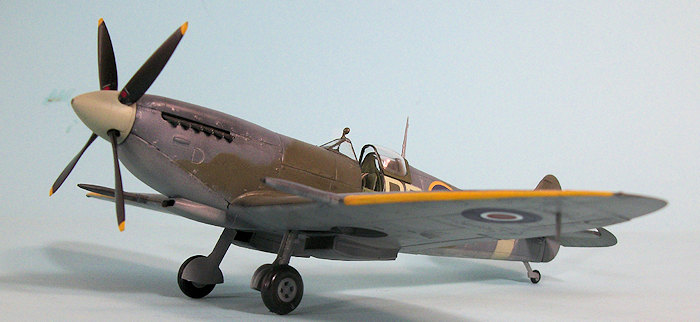 removed from the sprue, to remove sprue connection
points, and to be careful in assembly of sub-assemblies. If you do this, the
only place you will need any seam filler is with the upper cowling part (why
this wasn’t produced as one part as it should have been is beyond me).
removed from the sprue, to remove sprue connection
points, and to be careful in assembly of sub-assemblies. If you do this, the
only place you will need any seam filler is with the upper cowling part (why
this wasn’t produced as one part as it should have been is beyond me).
Many modelers have complained about the assembly of the exhausts, which are “uber-fiddly.” I figured out a way to get this done that is (at least to me) easier than what Eduard would have one do: I attached the lower part of the “engine block” to the inside of the nose, and let it set up. Then I glued the exhausts in position, following that with attaching the upper part of the “engine black.”
Past that, assembly of the kit is the same as any other Eduard Spitfire kit. With care, you will not need putty anywhere, but you must clean up the parts because fit is very precise.
| COLORS & MARKINGS |
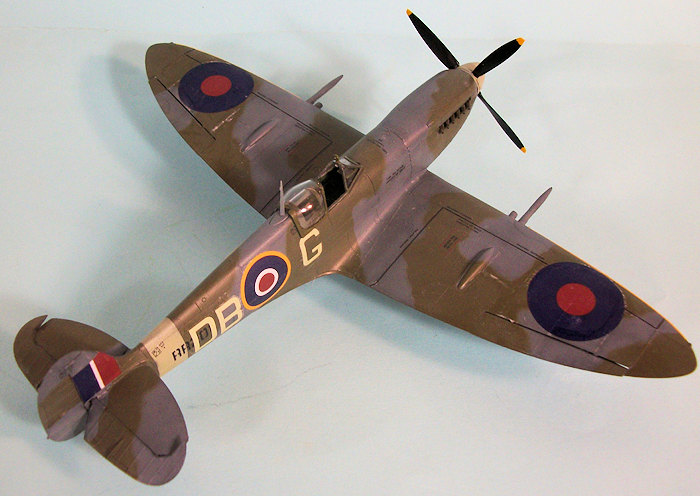 After painting the
leading edges of the outer wings yellow and masking that off, I freehanded the
camouflage using the Tamiya RAF colors: RAF Ocean Grey, RAF Dark Green, and RAF
Medium Sea Grey. Once dry, I gave the model a coat of clear Gloss.
After painting the
leading edges of the outer wings yellow and masking that off, I freehanded the
camouflage using the Tamiya RAF colors: RAF Ocean Grey, RAF Dark Green, and RAF
Medium Sea Grey. Once dry, I gave the model a coat of clear Gloss.
Since the Spitfire XVI and IXE are interchangeable, I decided to use the Victory Productions “Spitfire: Aces of the Empire” sheet to do the airplane flown by Flt Lt Dick Audet on his epic “Ace in a Day” mission. I applied all the stenciling decals first, then applied the Victory decals, which are perfect. The decals went down without problem under a coat of Solvaset. I then attached the landing gear and prop, unmasked the canopy and attached the bubble in the open position.
| CONCLUSIONS |
Eduard’s Spitfires are deservedly considered the best kits of the Merlin-60 series Spitfires available. They are a solid step up from any other similar kit. Any modeler who takes their time in assembly and finish of the kit is assured of a beautiful model. Highly recommended.
19 May 2016
Copyright ModelingMadness.com
Thanks to my wallet for the review kit.
If you would like your product reviewed fairly and fairly quickly, please contact the editor or see other details in the Note to Contributors.